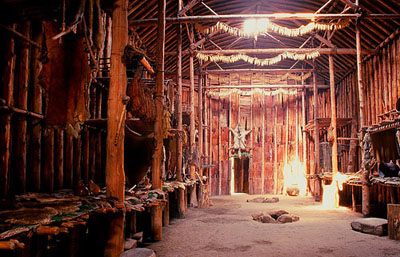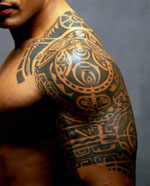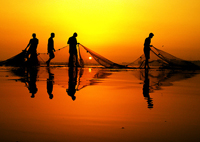Here you will find everything you need to know about Myri's City and her subjects. A vicious city filled with tigers, elephants, warriors, and hunters, Taloba stands as a monument to its Goddess of War. Though violent and blood thirsty, Myrians work as a strangely cohesive society of people, competition and worth driving each individual to outperform those in other clans and to prove their worth to the City and their Queen. Woe to the monsters of the jungle that dare approach the spear tipped walls marked by the bones of their enemies, and caution urged to strangers of Falyndar. Myrians are a ruthless and cunning race, slow to trust outsiders, but fiercely protective of those they deem of worth.
"Beware all ye enter the city of skulls and blood, for there are treasures more numerous than you can count, and twice as many dangers."
-An Ancient Inartan Proverb

The jungle encases you from all sides, grabbing and pulling with thorny vines and upturned roots. A maze of green everywhere you turn there is fauna choking up the ground and any space that gets even the tiniest sliver of sunlight. The only trails you find are thin pathways barely discernible through the forest floor.
And then suddenly, you break out into a clearing that reveals the massive walls of Taloba. Guards stand posted every few meters, eyes warily scanning the horizon, or cautiously chatting with comrades, and one black maw in the defense just big enough to fit three people abreast of each other acts as your only entrance into the city.
Welcome to Taloba.
 Once past the guards with their massive Myrian tigers, through the dark and stifling tunnel through the hanging bones, the entire city will open up to you in all of its savage glory. Once past the guards with their massive Myrian tigers, through the dark and stifling tunnel through the hanging bones, the entire city will open up to you in all of its savage glory.
Taloba is a strange amalgamation of stone and wood. Myrians are warriors first and builders second in all but a few cases, yet no barbarian that has entered the fanged city and merged alive from its embrace has ever complained about a lack of ferocious beauty. Carvings are one of the major components of the City. From an outside perspective Taloba may seem like a haphazard and poorly organized locale, every building from straw hut to massive stone temple is connected by the tales and grisly events depicted upon their walls and in their steps.

Wood is a main component of every building, but not necessarily simply the lumber. Myrians have lived a life very close to Caiyha, and as such are sparing in taking the natural resources put into their jungle by the Goddess of Flora and Fauna. As such Taloba has wide dirt packed roads much more traversed and orderly than the jungle trails, but the city is filled to the brim with wildlife and massive trunks of jungle trees. Many longhouses of clans that reside within Taloba are made around the support of these great trees, and though Myrians would be disgusted by the idea of dwelling within trees like the pathetic Symenestra they drove out of Falyndar so long ago, often the great plants will often support a second floor to homes as well.
 Clans of Taloba reside upon the edges of the city, forming a circle that almost completely covers the perimeter, this prioritizes space, leaving business, the military complex, and the temples in the center of the city, and also acts as a first line of defense. If anything managed to break through the walls of the City, a veritable army of already trained warriors would be immediately on hand to combat the issue. Clans of Taloba reside upon the edges of the city, forming a circle that almost completely covers the perimeter, this prioritizes space, leaving business, the military complex, and the temples in the center of the city, and also acts as a first line of defense. If anything managed to break through the walls of the City, a veritable army of already trained warriors would be immediately on hand to combat the issue.
The Trading Square, Tskanna and Tiger Training Yards, as well as the vast Military Training Complex takes up the majority of the rest of the City, with copses of woods, crumbling ruins, and even ponds and rivers interspersed between. While a jumble for any newcomer, a very discernible pattern of buildings and organization will slowly become apparent to a frequent passerby, and just as the Jungles of Falyndar hold a number of secrets, something similar can be said for the expansive home the Myrians have carved for themselves out in the wilds.
Aesthetic Inspiration: Mayan/ Aztec Ruins, Cambodian Ruins, Native American Architecture

 "As likely as taking Taloba."-An Old Kalean proverb "As likely as taking Taloba."-An Old Kalean proverb
As befits the citadel, sacred home and seat of power for the most warlike race in Mizahar, Taloba is heavily-defended at all times and massively-fortified. The Myrians found walls already roughly ringing the city when Myri first claimed it centuries ago, the ruins of some ancient civilization that predated even the jungle savages. Since then they have only been added to, and now a ring of yard-thick stone fifty feet tall surrounds the city entirely.
Taking a simple approach to defense, the Myrians have only ever had one entrance to their city: a gateway large enough for a Tskanna or three men standing abreast to enter, guarded at all times by a fang of warriors and a pair of Myrian Tigers. There are no other entrances, at least not above ground, and the Children of Myri have had centuries to ensure there are none below.
The walls are manned at all times by a full Tiger: one thousand Myrian warriors, all trained and tested fighters. A Claw is on duty at all times, patrolling the walls, watching the jungle beyond them and on gate duty. After eight hours, another Claw replaces them, then the third Claw after them, ensuring that the are always guarded and those guards always have time to refresh and train.
In addition, a Claw's worth of auxiliaries scurry and flit about the defenses around the clock, relaying messages, orders, reports and problems to commanders. The Myrians may appear savage to outsiders, but their knowledge of warfare is unparalleled, and they learned long ago that communications is as much a key to victory as sharp steel and training. As a result, thanks to a network of messenger pigeons, runners and semaphore, any incidents on the defenses are reported and responded to in chimes.
Outside the walls there used to be an additional defense: the Killing Ground, a cleared section of the jungle maybe half-a-kilometer thick that granted the defenders an unspoiled view of any approaching enemies. However, since the Djed Storm of 512AV, this area has become massively overgrown with vegetation, to the point vines and even trees have begun assaulting the walls, and teams of Myrians struggle around the clock to hack and burn this asset back into existence.
In keeping with the Myrians nature (and their thorough understanding of psychological warfare), the walls and towers of Taloba are dotted with spears and pikes decorated with the long-rotted corpses and heads of dead enemies. Dhani, human, Zith, and even stranger examples all hang from the walls for all to see, a silent and grisly warning to all who'd like to try the same.
But perhaps an even larger defense is the simple fact that the entire population of Taloba is, in fact, her defenders. A thousand males and females of the Taloba Army man her walls, but if they are breached and the alarm is raised, then within chimes fourteen thousand more will be on the warpath, and no army in history has withstood so many enraged Myrians...

Population of Taloba: 15,150
Myrians: 99%
Other: 1%
Due to the amount of animosity Myrians have for many other races, and outsiders in general, few barbarians enter and remain in Taloba. Of that 1% a good number of those are Kelvic who have found the savage nature of the Jungle Wilds and its people to their liking. The rest? Well you can be sure they have quite the tale for staying in the City of Bones.

It isn’t enough to say that Taloba is simply a matriarchal city, though the essence of this ideal is what guides how most of its citizens stand within the wall of bones and wood. Everyone barbarian, man, or beast, can earn their respect and place if they show their worth and prove their mettle, with little exception to this rule. One’s blood might make you a child of Myri, but if a barbarian is foolhardy and brave enough to bask in their Queen’s glory, they too can earn their place.
That being said, rarely if ever, do males find themselves in positions of political standing within Taloba. Myri learned long ago how egotistical and prideful males can be, and her council does not dispute such a decree. Truly stand out males become Tiger Riders, fang leaders, and even more rarely, clan heads, an honorable and impressive position for the lesser sex to uphold, and places many are eager to achieve. This difficulty holds doubly true for a male of any barbarian race or mixed blood, though barbarian females will have just as hard of an uphill struggle, it is naturally expected for them to excel over males.
Within this natural displacement of pure bloods over barbaric specimens, female over male, there are clan hierarchies, fang hierarchies, and even city dynamics and standings. A newly blooded soldier can find themselves a bit of fame by a noble or particularly cunning exploit, and though it may fade after the thick Taloban grog has worn off in the morning, the more stories one accumulates, the more dark eyes and tattooed necks will turn to look at you when you pass by. The question is, will it be respect or disdain that they grace you with? That. Is up to you.


Aside from the Sylirian Knights, the Myrians maintain the largest standing army in Mizahar. At its peak it stood at 3,500 trained warriors, but the destruction wreaked by the Djed Storm of 512AV reduced them to around 3000, hundreds of them killed or simply vanishing at the Zinrah Blockade. Since then both the Council of Nine and the Goddess-Queen herself have launched a recruiting drive, both to regain the numbers lost and prepare the Myrian people for what many see as an inevitable and looming conflict.
Organization
Fang (10-12)
The smallest unit of Myrian warriors, generally between 10-12 individuals led by a Fang Leader, usually a veteran and proven female. While smaller than the War Parties fielded by the clans, each member has been exhaustively trained in the arts of war, not to mention tracking, tactics and a separate system of bird-calls and hand signals used exclusively by the Army of Taloba.
War Party (20-60)
Named for the group of warriors and hunters that every Myrian clan is expected to be able to field for defense and patrolling, this formation is both more formalized and more fluid. It can consist of between two and five fangs, depending on the mission it has been designated, and is the typical force dispatched to answer barbarian incursions against the borders of Falyndar and reports of Dhani or Yukmen within them.
Claw (300)
Rarely deployed due to their size, a Claw consisted of five full-sized War Parties, usually commanded by one of Myri's Generals. Made up of hundreds of Myrian warriors, not to mention support elements like healers and djed-wielders, when a Claw goes on the warpath it's the sign of a major threat to Myri's domain.
Tigress (1000)
Aptly named after one of the fiercest beasts to be found in the jungle, the Tigress formation is made up of two front-line Claws, one reserve Claw, support elements and reserve units. There are three currently in service: one defending Taloba, another maintaining the Zinrah Blockade and patrolling the vast Jungle around it, and another held in reserve to be deployed in the most dire of emergencies. The last time there was such an emergency was the Djed Storm of 512AV, during which an entire Tigress marched from Taloba to restore the Blockade and slaughter everything un-Myrian they found around it.

The rule of law throughout Falyndar is brutally simple and, as a result, surprisingly effective. A reflection of both the Myrians that rule it and the Goddess-Queen that in turn rules them, punishment for crimes is swift and without appeal or mercy. Outside of Taloba, however, the jungle clans are charged with regulating their own ad hoc judicial systems under the aegis of Myri, and they do so.
In Taloba itself, law and order is maintained equally by Bina of the Red Orchid (nominal administrator of the city's running as a whole) and Rahi of the Tiger Eyed (spy mistress of the Council). The former oversees trials and sentences conducted and passed on criminals; the latter uses her impressive web of informants and spies to ensure such criminals are quickly found. A police force as we would understand it is generally unnecessary: all Myrians are capable of defending themselves and conducting "citizen arrests", although vigilante violence, i.e. bloodshed unsanctioned by the courts, is severely punished.
When a criminal is arrested, they are kept in the cells at The Garrison, ably secured by the few thousand Myrian warriors there most nights. Trials are conducted in The Plaza, and while crowds often gather to spectate, strict observance of the law is expected, as is good order. The defendant will be allowed to speak, or have another (usually a clan member) speak for him or her. If found guilty, however, there are no appeals. The sentence of the judge - most often an Elder Priestess or sometimes a Council member - is regarded as carrying the judgment of Myri Herself, and none of her children would dare question it.
Punishment varies from crime to crime. Thieves have a hand cut off. Murderers are beheaded. Traitors, regarded as the lowest of the low, are flayed and burned alive. Furthermore, their crime is seen as so heinous that their very names are stricken from all written documents, from clan records to military enlistments, as if they never existed. Laziness, public drunkenness and other minor offences are punished by flogging and sometimes branding of the face. Rape is surprisingly rare among Myrians, most likely a result of their matriarchal structure, but the few rapists that are caught and tried are beheaded, as such a crime is scene both as a violation of the flesh and soul, and thus unforgivable.
As you can see, most punishments are designed to preserve the usefulness of a criminal if possible. Sloth and weakness are no accepted in Taloba or Falyndar, and seeing as they do not keep slaves, Myri needs as many of her children as possible to work.
Law in the clan lands is more ad hoc but just as swift. In the clannish and intimate social structures of the clans, nothing is kept secret for long. Punishments are often the same as in Taloba, but ending the defendant's life is strictly prohibited save for the most grievous crimes. Clans found wantonly or unreasonably executing their own are punished in turn.
Crime in general is, however, quite rare in Falyndar, a fact that surprises many outsiders. Myrians are raised from birth to obey, whether its parents, elders, commanders and the Council, and potential criminals are "straightened out" at a young age.
It almost goes without saying that barbarian races (i.e. everyone not Myrian) who commit crimes in Falyndar are treated harshly. The rule against vigilante violence does extend to them, though, and so does Myri's law. They are tried and given a chance to defend themselves... but with Myrians being as they are, there is unlikely to be much sympathy for them. In the last hundred years, there have only been four occasions where barbarians on trial were found not guilty, and in all four cases there was massive evidence in their favor.
Barbarians who transgress in the clan lands are pretty much doomed. A blind eye is turned to such affairs, as to be frank, neither Myri nor her children care for the lives of the barbarian races, and if one or three happen to die in their jungle after making some misstep, so be it.

 It is hot and humid in Falyndar nearly year round, which not surprisingly encourages a severe lack of clothing for the residents of Falyndar. It is not uncommon to find both women and men traversing the dirt pathways of the city topless. Clothing is usually light and fast drying, like cotton. Leather and steel adornments are worn occasionally as status symbols or in serious battles, but not generally on a casual basis. Both men and women wear loin clothes, sashes, and kilts, and women also have the tendency to drape themselves with strips of cloth that can cover skin on a scale from everything to next to nothing. It is hot and humid in Falyndar nearly year round, which not surprisingly encourages a severe lack of clothing for the residents of Falyndar. It is not uncommon to find both women and men traversing the dirt pathways of the city topless. Clothing is usually light and fast drying, like cotton. Leather and steel adornments are worn occasionally as status symbols or in serious battles, but not generally on a casual basis. Both men and women wear loin clothes, sashes, and kilts, and women also have the tendency to drape themselves with strips of cloth that can cover skin on a scale from everything to next to nothing.
Since there is not much of a fashion show when it comes to clothing, ornaments, trophies, and adornments are how each Myrian marks themselves, their clan, and their individual identity within it. Tattoos, bits of glass, bone, and steel glinting within hair alongside their elaborate tattoos, this is how Myrians tell stories of their exploits and lives, making Taloba a living breathing tale as it were.

While all Myrians are fighters, there is a great variance in what these warriors of the jungle choose to do after their required stint in the military. For every soldier that stays on, dedicating their lives to the Taloban Corps, you will find many others that become potters, weapon smiths, veterinarians, and carvers. Taloba is a giant machine of industry and business, with everyone pulling their weight from children to elders, and a Myrian Nursery Rhyme puts it best: of the jungle choose to do after their required stint in the military. For every soldier that stays on, dedicating their lives to the Taloban Corps, you will find many others that become potters, weapon smiths, veterinarians, and carvers. Taloba is a giant machine of industry and business, with everyone pulling their weight from children to elders, and a Myrian Nursery Rhyme puts it best:
“Myri calls er Syna dawns, and every hand will work
Blood will run and backs will break but never will we stop
For the City of Bones can only rest once silver Leth has shone.”
 Just as each Myrian fights tooth and nail for their place within the Taloban standing, so too does a prospective business owner. Your spot in the Trading Square is only yours as long as you prove fit and able to keep it, and there are plenty of fights in the market over prospective territory. Setting up shop is as easy as pitching a tent and hawking your wares, but any merchant in Taloba fights just as hard for their place as a shopkeeper as they did in their military term. More permanent housing for structures such as hospitals, stables for animals, taverns, and lodging are generally dealt with in a much more organized, but no less competitive way. Usually these types of business and certain trades are maintained by specific clans over the course of generations. Just as each Myrian fights tooth and nail for their place within the Taloban standing, so too does a prospective business owner. Your spot in the Trading Square is only yours as long as you prove fit and able to keep it, and there are plenty of fights in the market over prospective territory. Setting up shop is as easy as pitching a tent and hawking your wares, but any merchant in Taloba fights just as hard for their place as a shopkeeper as they did in their military term. More permanent housing for structures such as hospitals, stables for animals, taverns, and lodging are generally dealt with in a much more organized, but no less competitive way. Usually these types of business and certain trades are maintained by specific clans over the course of generations.

Views on Magic:
The short answer: Mixed
The long answer? Somehow I knew you’d want the long answer.
Largely, Myrians see magic and those who spend the time to wield it, much as a tool. Magic can be a potent weapon and ally, and so those who wield it, if found worthy, are just as worthy of respect as those that master the sword, or mace, or bow.
On the same token, however, magic is much rarer than those that master weapons, and so those who can summon fireballs from the sky, transform into Tskanna, and who can create weapons of magical potency, are seen with a sense of awe as well as respect, for few understand the inner workings of Djed, though it is a part of us all. Those whose magical powers physically manifest and can be readily seen are generally respected more than passive disciplines like glyphing and shielding. This is an approximate break down of magic and how the majority of Myrians view it.
The Most Commonly Found Disciplines:
- Flux: A powerful way to test and strengthen one’s body
- Leeching: A mysterious ability of mage’s to steal each other’s energy
- Magecrafting: An exceedingly useful skill in order to enhance weapons and create powerful artifacts.
- Morphing: An admirable ability allowing for the imitation of the powerful and wondrous creatures of Caiyha’s realm.
- Malediction: A revered art of transforming the trophies of the dead into magical totems.
- Reimancy: A potent ability that allows one to control the elements themselves.
Uncommon Disciplines:
- Alchemy: An odd power to give objects different traits. Not always seen favorably.
- Glyphing: A strange way of storing one’s power in an object.
Rare Disciplines:
- Animation: This particular magic is seen as an affront to Caiyha, Dira, and Kihala, as it sits outside the realm that Myrians should inhabit, that of creating life.
- Familiary: Little is known of this discipline, but the idea of one being tied so closely to another strange and otherworldly being is generally looked down upon.
- Hypnotism: If a Myrian realizes you are using Hypnotism on them, it is seen as a great offense. It is better to not be known as a practitioner of this discipline as Myrians will see you as weak of body at best, and a threat that needs to be removed at worst.
- Projection: An underhanded mode of combat that allows one to trick their opponent. This an Hypnotism are often referred to as “Dhani Magic”
- Spiritism: There are few ghosts in Taloba, so there is very little need for spiritists.
- Shielding: There are very few shielders, as it is a primarily defensive tactic, and few Myrian mages see the benefits, just as few Myrians see the benefit of using shields when they can simply arm themselves with another weapon.
- Summoning: Seen as a strange and hated magic if people know of it. Since it involves otherworldly creatures it is seen as a barbaric and evil discipline.
- Voiding: Very little is known of this discipline.
Magic never before seen:
While these act as a generally consensus for Myrian opinions on these magic disciplines, cases will differ as will individual insight and views. Certain clans see magic as a crutch, while others are entirely magic based, and have a much deeper understanding of certain disciplines than the average Myrian solider. This list acts as a basic layout to guide your own writing as a mage or one who participates with them.
Credit goes to Limey for helping write up several sections of the current Codex |
|
![]() by Traverse on June 6th, 2013, 1:17 am
by Traverse on June 6th, 2013, 1:17 am ![]() by Traverse on July 16th, 2013, 12:02 am
by Traverse on July 16th, 2013, 12:02 am 






